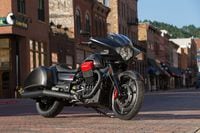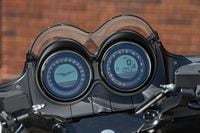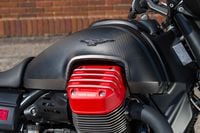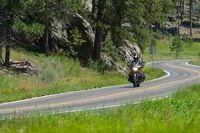We rode in formation through South Dakota’s Black Hills as if we owned the twisty roads. Our group consisted of about a dozen North American motojournalists accompanied by a small contingent of Moto Guzzi personnel, all riding the same model bike. And whenever we stopped for fuel, food, or photography people—mostly Harley-Davidson riders—clustered around our bikes like drones to the queen bee, and they asked in order: “What bike is it?” and “What does it cost?”
"It" was Moto Guzzi's new 2017 MGX-21 Flying Fortress, a distinctly styled bike billed as a bagger costing $21,990. Moreover, it performs like no other bagger on the planet, and yes, you read correctly—bagger, even though the MGX-21 looks, as one onlooker chimed, "like Batman's bike." No doubt the MGX's sensuous lines (tall and visually commanding up front, low and sleek at the rear) dressed with a sinister stealth-black finish and equally covert-ops carbon-fiber trim and accessories helped sway that man's opinion of the bike.
Now, about that bagger connotation: The MGX-21 is, by all rights, a bagger. The new Guzzi, based on the California platform, rolls with such bagger-associated goods as a 21-inch front wheel and tire, two swoopy-looking saddlebags to hold a claimed 58-liters worth of gear (and face it, a bike can't be a bagger unless it has bags), and a batwing-style fairing—a piece of ware that's typically associated with America's quintessential bagger-based platform, Harley's evergreen Electra Glide.
After spending two days in the MGX-21’s saddle during its press introduction in the Black Hills (home of the legendary Sturgis bike rally that was set to commence the following weekend), I question just how much of a bagger the Flying Fortress really is. Based on its performance across long, tedious stretches of interstate highways where you can utilize the bike’s standard cruise control and over challenging twisty back roads that favor its taut suspension, my perception is that it’s a bagger-style sport-touring motorcycle. It isn’t compromised by style—no, this thing is a hoot to ride. If you enjoy strafing apexes and bombing broad sweeping turns, yet it’s important that you pack some extra gear for the ride, you’ll walk away from the MGX-21 with a whole new attitude about baggers. As a boulevard bagger goes, maybe not so much.
The bike itself is based on Moto Guzzi’s California platform, powered by their big block engine. But the Flying Fortress uses thicker tubing and reinforced sections in parts of its frame to stiffen the chassis for a more precise ride. Claimed curb weight is 752 pounds, compared to the California Touring’s 710 pounds. You’ll feel the added weight when lifting the MGX-21 off its sidestand.
In addition, the steering-head geometry was slightly altered to prevent the 21-inch front wheel banging against the oil cooler at the base of the transverse V-twin engine. Proprietary footpegs position rider and passenger for a relaxed bend at the knees, and grabbing onto the dedicated alloy handlebar is easy, placing your torso in a semi-upright position. The slightly contoured seat’s firm padding offers plenty of support, but after an hour or so of steady riding the seat revealed an unwillingness to give in, resulting in some numb-butt as the miles accumulated beneath me. This was especially evident after long stretches of interstate.
Things get more interesting, though, when peeling off for a pass through some of the Black Hills’ twisting and turning back roads. The suspension, compliant for interstate and freeway riding, feels firm yet responsive when cornering, and the footpeg feelers brushed the asphalt only a few times at full lean. Spring and damping rates are well matched, although in a best-case scenario I could do with perhaps slightly softer damping to allow the springs to move more freely, especially during interstate travel. Even so, the ride is smooth and controlled, and as you grow more confident with the MGX’s behavior you begin to understand why this bike feels more like a sport-touring model than a bagger.
Yet every time you look at that 21-inch front wheel, you’re reminded of the bike’s bagger DNA. Turn-in for corners reminds you of that, too, because that big wheel promotes fork flop, especially during low-speed maneuvers, resulting in a “heavy” feel through the handlebar. Considering the size of the front wheel, though, it could have been worse. But Moto Guzzi spent a lot of time to get the steering geometry as correct as possible. Miguel Galluzzi, who heads PADC (Piaggio Advanced Design Center in Pasasdena, California) and who spearheaded the project, told me that three rake and trail variations were tried initially. After further development, Moto Guzzi settled on a combination that works, and to further confine fork flop to a livable level, engineers developed a unique spring-loaded damper that resides at the base of the steering head to further counter the effects. This is a patented design and it works rather well to keep the odd sensation in check. True, steering remains heavier than most bikes during low-speed turning, but with patience and practice I could perform U-turns on a two-lane road with little drama.
Best of all, though, the MGX-21’s prowess for straightening out twisty roads allows you to attack apexes with unabashed enthusiasm. The Dunlop tires (120/70R21 front, 180/60R16 rear) stick well, and the sexy-looking red Brembo calipers up front quickly bite their 320mm stainless steel rotors—only two fingers needed on the brake lever. Some journalists complained that the two-pot rear caliper and 282mm stainless steel rotor combo felt weak, but I didn’t notice any bad behavior from my bike. And as backup, ABS (anti-locking brake system) comes standard with the Flying Fortress.
Equally friendly is the big block engine that features Moto Guzzi’s elastic-kinematic mounting system to confine vibration while powering the Flying Fortress on each mission. There’s plenty of torque residing in the protruding cylinders that boast 104mm x 81.2mm bore and stroke. Good fuel metering coupled with precise electronics and 10.5:1 compression ratio translate to a claimed 96.6 horsepower at 6500 rpm, matched by 89.2 foot pounds of torque at 3000 rpm. Those are claimed figures, and I’m a believer in the torque figure for sure—during one run I lugged the engine to 1500 rpm in sixth gear (overdrive) before twisting the throttle. Following a moment of slight hesitation, the big-block engine responded, chugging the bike forward. By 2500 rpm I could feel it dig in, and the engine became noticeably smooth at 3000 rpm. By four grand it was pulling bike and rider along with full authority. Quite a ride! It’s best, of course, to select the proper gear from the smooth-shifting transmission. If you enjoy torque to set the pace, then this four-valve, 90-degree V-twin engine is for you.
The throttle by wire system offers three traction control modes too. In order of aggressiveness, Veloce (sport, or speed), Tourismo (touring) and Pioggia (rain, or standard) give you options to match road conditions. I favored Veloce for its more responsive snap. Engine heat isn’t much of an issue, either, thanks to stylish heat shields placed directly behind each cylinder to protect your knees from getting scorched.
As baggers go, the MGX-21 boasts the usual fanfare of electronic entertainment, too. A 25-watt-per-channel amplifier links to an AM/FM radio with two fairing-mounted speakers. There’s a Bluetooth module that hosts up to five devices, and a handy USB port is centrally located on the fairing’s dash for personal devices so you can deal with phone calls (using handlebar buttons) or enjoy your own tunes. Enough wind spills through the windscreen’s cleavage, though, to make the question of listening to any tunes moot when riding faster than 50 or so mph.
But none of those distracting features will matter after you realize just how responsive this “bagger” is during a ride through your favorite country back road. All you’ll concern yourself with is deciding which traction-control mode to select before pointing the big 21-inch front wheel in the direction that you’re headed. Then sit back and enjoy the ride. It’s the Italian way to ride a bagger.





















/cloudfront-us-east-1.images.arcpublishing.com/octane/FZXHNOQRNVA3BIDWAF46TSX6I4.jpg)
/cloudfront-us-east-1.images.arcpublishing.com/octane/JRSFLB2645FVNOQAZCKC5LNJY4.jpg)
/cloudfront-us-east-1.images.arcpublishing.com/octane/ITNLTIU5QZARHO733XP4EBTNVE.jpg)
/cloudfront-us-east-1.images.arcpublishing.com/octane/VZZXJQ6U3FESFPZCBVXKFSUG4A.jpg)
/cloudfront-us-east-1.images.arcpublishing.com/octane/QCZEPHQAMRHZPLHTDJBIJVWL3M.jpg)
/cloudfront-us-east-1.images.arcpublishing.com/octane/HXOUJXQWA5HBHGRO3EMJIGFMVI.jpg)

/cloudfront-us-east-1.images.arcpublishing.com/octane/3TIWWRV4JBBOLDVGRYECVVTA7Y.jpg)
/cloudfront-us-east-1.images.arcpublishing.com/octane/KIX5O23D5NAIBGFXBN3327DKZU.jpg)
/cloudfront-us-east-1.images.arcpublishing.com/octane/7GJYDUIPXRGMTMQKN6ONYOLBOU.jpg)
/cloudfront-us-east-1.images.arcpublishing.com/octane/MUQLOVLL2ZDGFH25ILABNBXKTI.jpg)
/cloudfront-us-east-1.images.arcpublishing.com/octane/TNOU5DNE2BC57MFPMGN2EIDXAM.jpg)
/cloudfront-us-east-1.images.arcpublishing.com/octane/GTCXACQGJ5HAPDTGWUQKDEH44E.jpg)
/cloudfront-us-east-1.images.arcpublishing.com/octane/S35YGSEMEZB4BLTDJTSZPF4GLA.jpg)
/cloudfront-us-east-1.images.arcpublishing.com/octane/5UOT6HPX2JFMRJAX6EH45AR4MQ.jpg)
/cloudfront-us-east-1.images.arcpublishing.com/octane/OKWOJWAKP5EP3OACCRRWPCIX2Q.jpg)
/cloudfront-us-east-1.images.arcpublishing.com/octane/2WF3SCE3NFBQXLDNJM7KMXA45E.jpg)
/cloudfront-us-east-1.images.arcpublishing.com/octane/G4MG6OUCJNBSHIS2MVVOTPX65E.jpg)
/cloudfront-us-east-1.images.arcpublishing.com/octane/IIGGWFOTOJGB7DB6DGBXCCMTDY.jpg)
/cloudfront-us-east-1.images.arcpublishing.com/octane/QSTCM6AVEZA5JJBUXNIQ3DSOF4.jpg)
/cloudfront-us-east-1.images.arcpublishing.com/octane/U4I7G625B5DMLF2DVIJDFZVV6M.jpg)
/cloudfront-us-east-1.images.arcpublishing.com/octane/B6XD6LS6IVCQPIU6HXDJSM3FHY.jpg)
/cloudfront-us-east-1.images.arcpublishing.com/octane/ICL63FEDDRDTTMINYICCEYGMDA.jpg)
/cloudfront-us-east-1.images.arcpublishing.com/octane/FCGZHQXRBZFLBAPC5SDIQLVF4I.jpg)